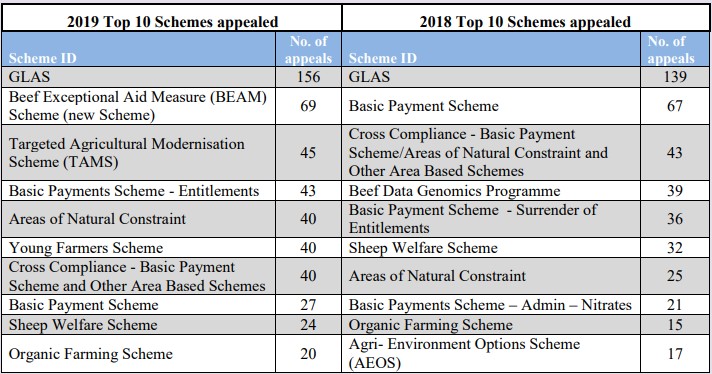The Green, Low-Carbon, Agri-Environment Scheme (GLAS) accounted for the lion’s share of the agricultural appeals made last year, according to the Agricultural Appeals Office, in its annual report for 2019.
Some 570 appeals were received last year, an increase of 2.5% when compared with 556 appeals received in 2018, but lower than the 10-year annual average of 708 appeals, the office notes.
Of these appeals, GLAS accounted for 156 appeals last year – the highest number of appeals for a scheme in 2019; which is a position it retains from 2018. This amounts to approximately 27% of cases, the office noted.
The office compiled a list of the top 10 schemes appealed last year – with a similar list from 2018 for comparative purposes, which shows the gulf between the most and second-most appealed schemes over the last two years.
Interestingly, the new scheme announced last year, the €75 million Beef Exceptional Aid Measure (BEAM), accounted for the second-highest number of appeals last year, with 69 such submissions lodged – about 12% of cases.
- Low-input permanent pasture action: No owned bovines, heather, parcel not stock-proofed, feeding of forage to cattle taking place on the parcel;
- Coppicing action: Coppicing not carried out or not carried out on the location indicated;
- Protection of watercourses from bovines action: No bovines on holding, inadequate fencing of the watercourses;
- Failure to complete an action over the term of the contract; and
- Ineligible land found on the Basic Payment Scheme (BPS) check; use declared on the BPS (and other area schemes) annual application was different to that undertaken in the original application for GLAS.
Meanwhile, for BEAM, the office noted that the department’s findings on the new scheme included: milk suppliers being non-compliant due to the number of dairy cows; and animals not presented for slaughter by the farmer applying for the measure – in some cases animals were sold by a farmer to another herdowner and the animal was sold for slaughter within a few days of sale.
Other findings included animals being presented for slaughter outside of the reference dates and late applications being submitted, the office said.

